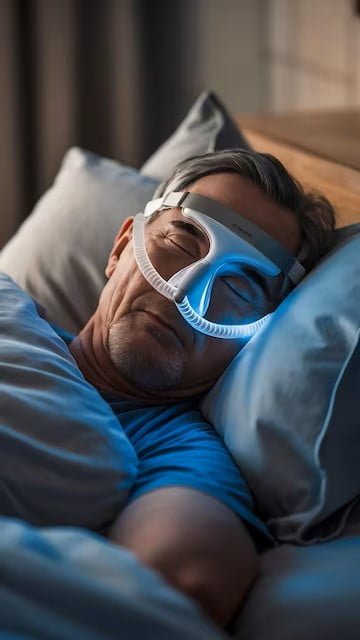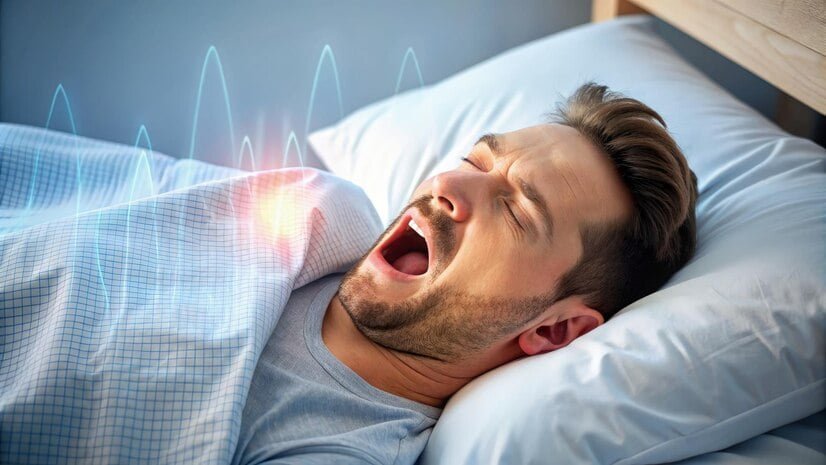Table of Contents
Sleep Apnea
Sleep apnea is a serious sleep disorder where breathing repeatedly stops and starts during sleep. It can have significant health consequences if left untreated, potentially leading to life-threatening conditions. This article will explore whether sleep apnea can kill you, how it affects your body, and the risks associated with ignoring its symptoms.

What is Sleep Apnea?
Sleep apnea occurs when the airway becomes partially or completely blocked, limiting airflow into the lungs. This leads to interrupted breathing during sleep, causing the body to wake up briefly to resume breathing. There are three main types of sleep apnea:
- Obstructive Sleep Apnea (OSA): The most common form, where the throat muscles relax excessively.
- Central Sleep Apnea: Occurs when the brain fails to send the correct signals to control breathing.
- Complex Sleep Apnea Syndrome: A combination of both obstructive and central sleep apnea.
Can Sleep Apnea Kill You?
While sleep apnea itself doesn’t directly kill you, it can significantly increase the risk of life-threatening complications if left untreated. The condition puts immense stress on the body, particularly the cardiovascular and respiratory systems. This chronic stress can lead to severe health issues that may be fatal over time, including:
- 1. Heart Attack: Sleep apnea significantly increases the risk of heart attack due to the lack of oxygen during sleep. When the body experiences low oxygen levels repeatedly, it triggers stress responses that can elevate blood pressure and heart rate. Over time, this can lead to heart disease and heart attacks, which can be fatal.
- 2. Stroke: Untreated sleep apnea can also lead to an increased risk of stroke. The repeated oxygen deprivation impacts blood flow to the brain, increasing the likelihood of clots or hemorrhages that can result in a stroke, a leading cause of death worldwide.
- 3. High Blood Pressure (Hypertension): Sleep apnea can cause chronic high blood pressure, which puts a strain on the heart and arteries. This strain increases the risk of heart failure, aneurysms, and other cardiovascular diseases that can be fatal.
- 4. Sudden Cardiac Death: For individuals with severe sleep apnea, there is a higher risk of sudden cardiac death, particularly during sleep. The body’s inability to maintain normal breathing patterns during sleep can cause fatal arrhythmias, where the heart beats irregularly or stops altogether.
- 5. Diabetes: Sleep apnea is associated with insulin resistance and an increased risk of type 2 diabetes. While diabetes itself is not fatal, the complications it causes—such as kidney failure, heart disease, and nerve damage—can be life-threatening, especially when combined with sleep apnea.
- 6. Car Accidents: People with untreated sleep apnea often suffer from excessive daytime sleepiness due to the constant sleep disruptions. This can impair focus and reaction times, making them more prone to accidents. Falling asleep at the wheel or having delayed reactions while driving can result in fatal accidents.
Other Health Risks of Sleep Apnea
In addition to life-threatening conditions, untreated sleep apnea can contribute to a range of other health issues, such as:

- Cognitive Decline: Memory loss, difficulty concentrating, and impaired cognitive function can result from poor-quality sleep caused by sleep apnea.
- Depression and Anxiety: Sleep apnea has been linked to mood disorders like depression and anxiety, further affecting overall quality of life.
- Liver Problems: Research shows that people with sleep apnea are more likely to experience abnormal liver function and scarring of the liver (nonalcoholic fatty liver disease).
Symptoms of Sleep Apnea to Watch For
Recognizing the symptoms of sleep apnea early on can be life-saving. Common signs include:
- Loud snoring
- Gasping for air during sleep
- Excessive daytime sleepiness
- Difficulty concentrating
- Morning headaches
- Dry mouth or sore throat upon waking
- Mood changes, such as irritability
If you or someone you know is experiencing these symptoms, it’s crucial to seek medical attention to diagnose and manage sleep apnea.
Treatment for Sleep Apnea
Thankfully, sleep apnea is treatable. Common treatments include:
- Continuous Positive Airway Pressure (CPAP) therapy: A machine that delivers steady air pressure to keep airways open during sleep.
- Lifestyle Changes: Losing weight, quitting smoking, and avoiding alcohol can help reduce the severity of sleep apnea.
- Surgery: In some cases, surgery to remove excess tissue from the throat or adjust the jaw may be necessary to treat sleep apnea.
How is Sleep Apnea Diagnosed?
Diagnosing sleep apnea involves a combination of evaluating medical history, symptoms, and conducting specific tests to confirm the presence of the disorder. Here’s a detailed look at the diagnostic process:

1. Medical History and Physical Examination
The diagnostic process usually begins with a comprehensive review of your medical history and a physical examination. Your healthcare provider will ask about:
- Symptoms: Common symptoms include loud snoring, choking or gasping during sleep, excessive daytime sleepiness, and difficulty concentrating.
- Medical History: This includes any existing health conditions, lifestyle factors (such as obesity or smoking), and family history of sleep disorders.
- Sleep Patterns: Information about your sleep habits and patterns, including the quality and duration of your sleep, will be gathered.
2. Sleep Questionnaires
Healthcare providers may use sleep questionnaires to assess your symptoms and their severity. Common questionnaires include:
- Epworth Sleepiness Scale: Measures your level of daytime sleepiness.
- Pittsburgh Sleep Quality Index (PSQI):** Evaluates sleep quality and disturbances over a one-month period.
- Berlin Questionnaire: Assesses the risk of sleep apnea based on your symptoms and risk factors.
3. Polysomnography (Sleep Study)
A definitive diagnosis of sleep apnea usually requires a sleep study called polysomnography. This test is conducted in a sleep center or sometimes at home and involves:
- Overnight Monitoring: You will be monitored while you sleep, either in a sleep clinic or using a home-based device.
- Electrodes and Sensors: Sensors will be attached to your scalp, face, chest, and legs to monitor brain activity, eye movements, muscle activity, heart rate, breathing patterns, and oxygen levels.
- Data Analysis: The collected data helps in evaluating the number of apneas (breathing pauses), hypopneas (shallow breathing), oxygen desaturation, and other sleep disturbances.
4. Home Sleep Apnea Testing (HSAT)
In some cases, especially for individuals with a high likelihood of obstructive sleep apnea and no other significant health issues, a home sleep apnea test may be used. This involves:
- Portable Monitoring Device: You use a device at home that measures breathing patterns, heart rate, and oxygen levels.
- Convenience: It is more convenient and less expensive than an in-lab sleep study but may not be suitable for everyone.
5. Additional Tests
Depending on the results of initial tests, additional tests or assessments might be recommended:
- Cardiopulmonary Stress Test: Evaluates how your heart and lungs respond to physical exertion.
- Imaging Studies: In some cases, imaging studies like a CT scan or MRI may be used to identify anatomical issues contributing to sleep apnea.
6. Consultation with a Specialist
Following the initial evaluation and diagnostic tests, you may be referred to a sleep specialist for a more in-depth analysis and treatment planning. The specialist will interpret the test results and recommend appropriate treatment options based on the severity and type of sleep apnea.
Understanding the Initial Stages of Sleep Apnea
Sleep apnea is a serious condition that often develops gradually, with its initial stages sometimes going unnoticed. Early recognition of the symptoms is crucial for effective management and prevention of more severe complications. Here’s a detailed look at the initial stages of sleep apnea, including early symptoms, risk factors, and the importance of early intervention.
1. Early Symptoms of Sleep Apnea
In its initial stages, sleep apnea may present subtle symptoms that can easily be overlooked or attributed to other causes. Common early signs include:
- Loud Snoring: While snoring alone doesn’t indicate sleep apnea, it is often one of the first noticeable signs. If snoring is loud and disruptive, it may signal an obstructive airway.
- Frequent Nighttime Waking: Individuals may wake up multiple times during the night due to breathing interruptions, though they may not always remember these awakenings.
- Gasping or Choking Sounds: Witnessed by bed partners, these sounds occur when the airway becomes blocked and then reopens abruptly.
- Excessive Daytime Sleepiness: Feeling unusually tired or drowsy during the day, even after a full night’s sleep, can be a sign of disrupted sleep caused by sleep apnea.
2. Identifying Risk Factors of Sleep apnea
Several factors increase the likelihood of developing sleep apnea, even in its early stages. Key risk factors include:
- Obesity: Excess weight, particularly around the neck and throat area, can increase the risk of airway obstruction.
- Age: Sleep apnea risk increases with age, as muscle tone in the throat decreases over time.
- Gender: Men are more likely to develop sleep apnea than women, although the risk for women increases after menopause.
- Anatomical Factors: Structural abnormalities in the throat, such as a large tongue or small airway, can contribute to sleep apnea.
- Family History: A family history of sleep apnea or other sleep disorders can increase susceptibility.
- Lifestyle Factors: Smoking, alcohol consumption, and sedative use can exacerbate or trigger sleep apnea symptoms.
3. Consequences of Early-Stage Sleep Apnea
If early-stage sleep apnea is left untreated, it can lead to a range of health issues, including:
- Increased Risk of Cardiovascular Problems: Ongoing oxygen deprivation can strain the heart, potentially leading to high blood pressure, heart disease, and stroke.
- Impaired Cognitive Function: Chronic sleep disturbances can affect memory, concentration, and overall cognitive function.
- Metabolic Issues: Sleep apnea can contribute to weight gain, insulin resistance, and type 2 diabetes.
- Mood Disorders: Persistent sleep issues can lead to mood swings, depression, and anxiety.
4. Importance of Early Diagnosis
Early diagnosis is crucial to prevent the progression of sleep apnea and mitigate its health impacts. If you or someone you know is experiencing early symptoms, it is essential to:
- Seek Medical Evaluation: Consult a healthcare provider or sleep specialist if early symptoms are present. They can perform a thorough evaluation and recommend appropriate diagnostic tests.
- Monitor Symptoms: Keeping track of symptoms and any changes in sleep patterns can provide valuable information for diagnosis.
- Adopt Healthy Habits: Addressing risk factors such as obesity, smoking, and alcohol consumption can help manage or reduce the severity of sleep apnea.
5. Diagnosis and Management
Once sleep apnea is suspected, a comprehensive diagnostic process typically includes:
- Medical History and Physical Examination: Discussing symptoms and risk factors with a healthcare provider.
- Sleep Studies: Conducting polysomnography or home sleep apnea testing to confirm the presence and severity of sleep apnea.
- Treatment Options: Based on the diagnosis, treatment may involve lifestyle changes, CPAP therapy, or other interventions to manage the condition effectively.
FAQ on Sleep Apnea
1. What is Sleep Apnea?
Sleep apnea is a sleep disorder characterized by repeated interruptions in breathing during sleep. These interruptions can be due to the throat muscles relaxing excessively (obstructive sleep apnea) or the brain failing to send the correct signals to control breathing (central sleep apnea).
2. Can Sleep Apnea Kill You?
While sleep apnea itself may not directly kill you, untreated sleep apnea can lead to severe health complications such as heart attacks, strokes, high blood pressure, and sudden cardiac death. The chronic stress on the cardiovascular and respiratory systems can increase the risk of these life-threatening conditions.
3. How is Sleep Apnea Diagnosed?
Sleep apnea is diagnosed through a combination of medical history evaluation, physical examination, sleep questionnaires, and specialized tests such as polysomnography (sleep study) or home sleep apnea testing. A comprehensive assessment by a healthcare provider or sleep specialist is necessary for accurate diagnosis.
4. What Are the Initial Stages of Sleep Apnea?
In its early stages, sleep apnea may present with symptoms such as loud snoring, frequent nighttime awakenings, gasping or choking sounds during sleep, and excessive daytime sleepiness. Risk factors include obesity, age, gender, anatomical factors, family history, and lifestyle choices.
5. What Should I Do if I Suspect Sleep Apnea?
If you suspect sleep apnea, consult a healthcare provider for an evaluation. They may recommend a sleep study or other diagnostic tests to confirm the condition. Early diagnosis and treatment are crucial for managing sleep apnea and preventing complications.
6. What Are Common Treatments for Sleep Apnea?
Common treatments for sleep apnea include:
- Continuous Positive Airway Pressure (CPAP) Therapy: A machine that keeps the airway open during sleep.
- Lifestyle Changes: Weight loss, quitting smoking, and avoiding alcohol can help reduce symptoms.
- Surgery: In some cases, surgery may be necessary to remove excess tissue from the throat or adjust the jaw.
7. What Are the Long-Term Risks of Untreated Sleep Apnea?
Long-term risks of untreated sleep apnea include cardiovascular problems (such as heart disease and stroke), cognitive decline, metabolic issues like diabetes, mood disorders, and liver problems. Managing sleep apnea early can help prevent these severe health issues.
8. Can Sleep Apnea Cause Cognitive Decline?
Yes, untreated sleep apnea can lead to cognitive decline. Disrupted sleep patterns affect memory, concentration, and overall cognitive function, making it essential to seek treatment if you experience symptoms.
Conclusion
While sleep apnea may not directly kill you, its complications can be life-threatening if left untreated. The condition significantly raises the risk of heart disease, stroke, high blood pressure, and sudden cardiac death. Moreover, it contributes to other serious health issues, including diabetes, liver problems, and cognitive decline. If you suspect you have sleep apnea, it’s essential to seek a medical diagnosis and follow appropriate treatments to mitigate the risks. Early intervention can significantly improve your quality of life and reduce the chance of fatal complications.
Diagnosing sleep apnea involves a multi-step approach starting with a thorough review of symptoms and medical history, followed by specialized sleep studies to confirm the disorder. Polysomnography is the gold standard for diagnosing sleep apnea, although home sleep apnea tests can also be effective in certain cases. A comprehensive evaluation by a healthcare provider or sleep specialist is crucial to accurately diagnose sleep apnea and determine the most effective treatment plan.
The initial stages of sleep apnea may be subtle but recognizing early symptoms and risk factors is key to preventing the condition from worsening. Early intervention through proper diagnosis and treatment can significantly improve quality of life and reduce the risk of severe complications. If you suspect sleep apnea or experience related symptoms, seeking medical advice promptly is essential for effective management and long-term health. Read more about your Health


Can you be more specific about the content of your article? After reading it, I still have some doubts. Hope you can help me.
Thanks for sharing. I read many of your blog posts, cool, your blog is very good.